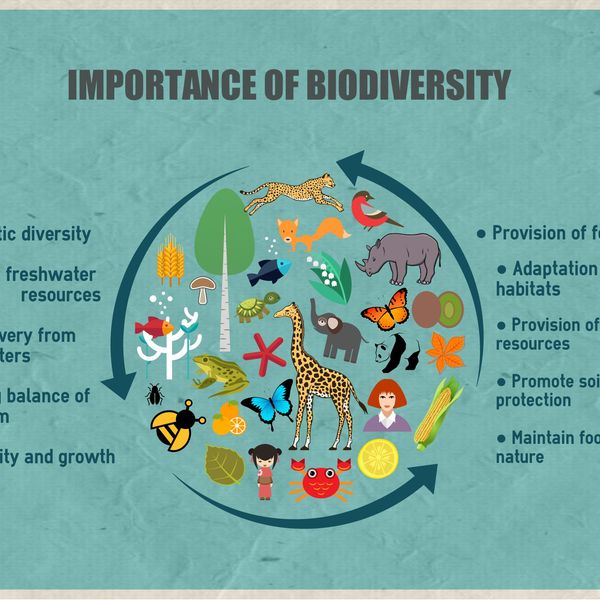Importance of Biodiversity
Biodiversity is important because we depend on the living organisms on our Earth. As we have done in the past, we continue to depend on healthy ecosystems and on the millions of animals, plants, fungus, and microbial species that we share the Earth. We rely on such ecosystem benefits as the production of oxygen through photosynthesis, the purification of water, the natural cycling of carbon and nitrogen, and other elements vital to life. We continue to utilize biodiversity for food, medicine, clothing, and shelter (AMNH, 2019). The beauty of life awakens a moral commitment within ourselves, to take care of the living organisms around us.
Human activity is the biggest cause of habitat loss. The planet’s human population has doubled in the past 50 years. Now there is a pressure for the Earth to be able to house and feed over seven billion people. The nature of wild habitats have spread, through the human impacts on the Earth’s radical change in weather patterns. The clearing of land for agriculture, is the main individual cause of loss of habitat. It has been estimated that 177,000 square kilometers of forests and woodlands are cleared annually. The habitats in marine zones and oceans are also being destroyed, this is happening through: urbanization, industrialisation, and tourism. Moreover, they are all affecting habitats in coastal areas. Of the population 40% live within 100 kilometers of the coast, which has placed major strains on wetlands and oceans (World Wide Fund for Nature, 2017).
Treats and Protection
The main threats to biodiversity include: climate change, deforestation and habitat loss, overexploitation, invasive species, and pollution. In general, climate is a major factor in the distribution of species across the globe; climate change forces them to adjust. Many are not able to adjust, causing many species to die out. Deforestation is causing extinction and loss of biodiversity, directly. This is happening because space is being made for farming or to harvest timber for fuel and wood products. Overexploitation includes overhunting, overfishing, and overharvesting. Furthermore, they are killing off many species. All form of hunting and poaching for profit are increasing the risk of extinction. These could include extinction of a predator on top of the food chain, which would result in catastrophic consequences for the ecosystems. Invasive species being introduced into an ecosystem can threaten native species and species restricted to a specific geographical area, either as a predator or as a competitor for resources. Lastly, pollution is occurring through the burning of fossil fuels to the dumping of plastic in the ocean. Pollution completely disrupts the Earth’s ecosystems (Petronzio, 2015).
There are three major aspects that can be done to protect biodiversity; as a consumer, personal lifestyle choices, and citizen actions. As a consumer, buying patterns should be evaluated. Based on those the consumer should learn about the hidden environmental costs of manufacturing and transporting goods. Buy products that last longer and have less environmental impact in their production, use, and disposal. Make practical ethical choices about what you need to be a informed buyer and buy from companies that offer green products. Also, join local and national co-ops or buying groups as a way to find the products you want and to increase your purchasing influence. Also, reduce your energy, conduct an energy audit for your home and take steps to reduce waste; shift to energy and resource-efficient appliances. Lifestyle choices should be changed to include fewer negative impacts on the environment. Consider the impact of the transportation you use and choose energy effective transportation: bike, walk, and public transportation. Track your transportation usage and expenses. Join support groups that are promoting realistic but efficient ways of changing life styles, can be joined. As citizens of this Earth our actions should consider all organisms. Furthermore, this is why families should be planned out, because of our current overpopulation. Think carefully about your desired family size and the resources required such as education, clothing, and food.
Climate Change and Biodiversity
The link between climate change and biodiversity has long been established. Although throughout Earth’s history the climate has always changed with ecosystems and species coming and going. Climates have changed at alarming rates, due to the human activity. The rapid change in speed does not give ecosystems and species the time to adapt (AMHN, 2019).
The visit to the AMHN was very eye opening. The exhibit of biodiversity had multiple elements that made the viewer feel engaged. That feeling in the exhibit lets you understand and remember the information better. Interactive components also let the visitor have a hands on experience. The showcase of multiple extinct species was most interesting to me. It lets the viewer want to save those species, through being environmentally friendly. The lights also spotlighted the most important aspects. The only thing I would change is the darkness of the exhibit, but maybe that alludes to the darkness of our society.

